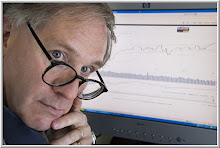


It's been a day of dollar weakness against both the Euro (middle chart) and Yen (bottom chart). Interestingly, it's also a day in which 30 yr bond yields (top chart) are up smartly and approaching the 5% level. The Fed rate cut makes the dollar less attractive relative to higher yielding currencies, but now we're seeing a situation in which the dollar has quite likely peaked vs. the Yen. If so, that makes the carry trade--the borrowing of cheap Yen to finance trades in (among other things) equities--less appealing.
Dollar weakness also raises the likelihood that investors will demand greater return (higher yields) for holding dollars and dollar-denominated assets. That puts pressure on bond prices (and raises yields).
How would rising long-term rates affect the economy, financial issues and housing in particular? I note that, today, banking stocks ($BKX) were down nearly 2%-- far weaker than the S&P 500 Index ($SPX). And housing? The homebuilders index ($HGX) has sharply reversed its strength from earlier this week and closed down over 4% on the day. It's now hovering near its bear lows. Rising long-term rates can't be good for housing.
I submit that the Fed action has accelerated a number of investment themes that will affect returns in the foreseeable future. Financial assets are losers in a stagflationary environment; the tangible assets mentioned in my recent post become the clear winners.
RELEVANT POST:
Interest Rates and Stocks
.




